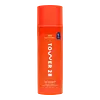What's inside
What's inside
 Key Ingredients
Key Ingredients

 Benefits
Benefits

 Concerns
Concerns

 Ingredients Side-by-side
Ingredients Side-by-side

Water
Skin ConditioningGlycerin
HumectantDipropylene Glycol
HumectantCocamidopropyl Betaine
CleansingButylene Glycol
HumectantBentonite
AbsorbentSodium Methyl Cocoyl Taurate
CleansingPotassium Cocoyl Glutamate
Xanthan Gum
EmulsifyingSodium Acetylated Hyaluronate
HumectantSodium Hyaluronate
HumectantSericin
Skin ConditioningGlycine Soja Seed Extract
Skin ConditioningCitric Acid
BufferingSodium Citrate
BufferingSodium Metabisulfite
AntioxidantEthoxydiglycol
HumectantBis-Ethoxydiglycol Cyclohexane 1,4-Dicarboxylate
EmollientCentella Asiatica Extract
CleansingPotassium Sorbate
PreservativeTocopherol
AntioxidantPhenoxyethanol
PreservativeParfum
MaskingCI 77288
Cosmetic ColorantWater, Glycerin, Dipropylene Glycol, Cocamidopropyl Betaine, Butylene Glycol, Bentonite, Sodium Methyl Cocoyl Taurate, Potassium Cocoyl Glutamate, Xanthan Gum, Sodium Acetylated Hyaluronate, Sodium Hyaluronate, Sericin, Glycine Soja Seed Extract, Citric Acid, Sodium Citrate, Sodium Metabisulfite, Ethoxydiglycol, Bis-Ethoxydiglycol Cyclohexane 1,4-Dicarboxylate, Centella Asiatica Extract, Potassium Sorbate, Tocopherol, Phenoxyethanol, Parfum, CI 77288
Water
Skin ConditioningDecyl Glucoside
CleansingAloe Barbadensis Leaf Juice
Skin ConditioningNiacinamide
SmoothingCaprylyl/Capryl Glucoside
CleansingPhenoxyethanol
PreservativeGlycerin
HumectantCaprylyl Glycol
EmollientCitric Acid
BufferingChlorphenesin
AntimicrobialMagnesium Aspartate
Skin ConditioningZinc Gluconate
Skin ConditioningAlgin
MaskingAchillea Millefolium Extract
CleansingAvena Sativa Kernel Extract
AbrasiveCardiospermum Halicacabum Flower/Leaf/Vine Extract
Skin ConditioningSapindus Mukorossi Peel Extract
Skin ConditioningPanthenol
Skin ConditioningCopper Gluconate
Skin ConditioningWater, Decyl Glucoside, Aloe Barbadensis Leaf Juice, Niacinamide, Caprylyl/Capryl Glucoside, Phenoxyethanol, Glycerin, Caprylyl Glycol, Citric Acid, Chlorphenesin, Magnesium Aspartate, Zinc Gluconate, Algin, Achillea Millefolium Extract, Avena Sativa Kernel Extract, Cardiospermum Halicacabum Flower/Leaf/Vine Extract, Sapindus Mukorossi Peel Extract, Panthenol, Copper Gluconate
 Reviews
Reviews

Ingredients Explained
These ingredients are found in both products.
Ingredients higher up in an ingredient list are typically present in a larger amount.
Citric Acid is an alpha hydroxy acid (AHA) naturally found in citrus fruits like oranges, lemons, and limes.
Like other AHAs, citric acid can exfoliate skin by breaking down the bonds that hold dead skin cells together. This helps reveal smoother and brighter skin underneath.
However, this exfoliating effect only happens at high concentrations (20%) which can be hard to find in cosmetic products.
Due to this, citric acid is usually included in small amounts as a pH adjuster. This helps keep products slightly more acidic and compatible with skin's natural pH.
In skincare formulas, citric acid can:
While it can provide some skin benefits, research shows lactic acid and glycolic acid are generally more effective and less irritating exfoliants.
Most citric acid used in skincare today is made by fermenting sugars (usually from molasses). This synthetic version is identical to the natural citrus form but easier to stabilize and use in formulations.
Read more about some other popular AHA's here:
Learn more about Citric AcidGlycerin is already naturally found in your skin. It helps moisturize and protect your skin.
A study from 2016 found glycerin to be more effective as a humectant than AHAs and hyaluronic acid.
As a humectant, it helps the skin stay hydrated by pulling moisture to your skin. The low molecular weight of glycerin allows it to pull moisture into the deeper layers of your skin.
Hydrated skin improves your skin barrier; Your skin barrier helps protect against irritants and bacteria.
Glycerin has also been found to have antimicrobial and antiviral properties. Due to these properties, glycerin is often used in wound and burn treatments.
In cosmetics, glycerin is usually derived from plants such as soybean or palm. However, it can also be sourced from animals, such as tallow or animal fat.
This ingredient is organic, colorless, odorless, and non-toxic.
Glycerin is the name for this ingredient in American English. British English uses Glycerol/Glycerine.
Learn more about GlycerinPhenoxyethanol is a preservative that has germicide, antimicrobial, and aromatic properties. Studies show that phenoxyethanol can prevent microbial growth. By itself, it has a scent that is similar to that of a rose.
It's often used in formulations along with Caprylyl Glycol to preserve the shelf life of products.
Water. It's the most common cosmetic ingredient of all. You'll usually see it at the top of ingredient lists, meaning that it makes up the largest part of the product.
So why is it so popular? Water most often acts as a solvent - this means that it helps dissolve other ingredients into the formulation.
You'll also recognize water as that liquid we all need to stay alive. If you see this, drink a glass of water. Stay hydrated!
Learn more about Water